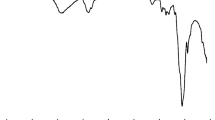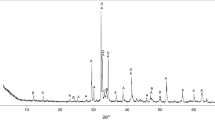Abstract
The hydration of the binder, consisting of calcium aluminate cement (CAC) with Al2O3 >70% and with or without the additives of the FCC catalyst waste and polycarboxylate deflocculant Castament FS-20, is investigated. The methods of calorimetry, thermal analysis, XRD, electrical conductivity, SEM, as well as ultrasonic wave velocity measuring and bending strength evaluation are used. The results of the investigation show that the FCC catalyst as well as polycarboxylate deflocculant, are active additives, influencing the CAC binder’s hydration process. In the structure of the hardened binders, certain amounts of unhydrated CAC minerals, CA, and CA2, and the hydration products, such as CAH10, C2AH8 and the amorphous AH3, are found. However, in the binder with a deflocculant, there are smaller amounts of CAH10 and the amorphous AH3, though the amount of C2AH8 is higher than that in the binder without a deflocculant additive. It has been found that in the case, when the FCC catalyst and deflocculant are simultaneously used, the FCC catalyst produces a positive effect on the formation of the CAC binder’s structure, increasing its mechanical strength. The results obtained in this article allow to predict that the FCC catalyst and deflocculant simultaneously used as the additives to the CAC binder, will enable to control the hydration process of the binder.










Similar content being viewed by others
References
Pacewska B, Wilińska I, Bukowska M. Hydration of cement slurry in the presence of spent cracking catalyst. J Therm Anal Calorim. 2000;60(1):71–8.
Hsu K-C, Tseng Y-S, Ku F–F, Su N. Oil cracking waste catalyst as an active pozzolanic material for superplasticized mortars. Cem Concr Res. 2001;31(12):1815–20.
Pacewska B, Wilińska I, Bukowska M. Calorimetric investigations of the influence of waste aliumosilicate on the hydration of different cements. J Therm Anal Calorim. 2009;97(1):61–6.
Aleknevičius M, Antonovič V. Calorimetric investigations of high aluminate cement hydration in the presence of waste oil-cracking catalyst. Chem technol. 2009;51(2):33–8.
Pacewska B, Bukowska M, Wilińska I, Swat M. Modification of the properties of concrete by a new pozzolan—a waste catalyst from the catalytic process in a fluidized bed. Cem Concr Res. 2002;32(1):145–52.
Payá J, Monzó J, Borrachero MV, Velázquez S. Evaluation of the pozzolanic activity of fluid catalytic cracking catalyst residue (FC3R). Thermogravimetric analysis studies on FC3R-portland cement pastes. Cem Concr Res. 2003;33(4):603–9.
Garcia de Lomas M, Sáncches de Rojas MIS, Frías M. Pozzolanic reaction of a spent fluid catalytic cracking catalyst in FCC-cement mortars. J Therm Anal Calorim. 2007;90(2):443–7.
Pacewska B, Nowacka M, Wilinska I, Kubissa W, Antonovich V. Studies on the influence of spent FCC catalyst on hydration of calcium aluminate cements at ambient temperature. J Therm Anal Calorim. 2011;105(1):129–40.
Payá J, Monzó J, Borrachero MV. Fluid catalytic cracking catalyst residue (FC3R) an excellent mineral by-product for improving early-strength development of cement mixtures. Cem Concr Res. 1999;29(11):1773–9.
Su N, Fang H, Chen Z, Liu F. Reuse of waste catalysts from petrochemical industries for cement substitution. Cem Concr Res. 2000;30(11):1773–83.
Payá J, Monzó J, Borrachero MV, Velázquez S. Chemical activation of pozzolanic reaction of fluid catalytic cracking catalyst residue (FC3R) in lime pastes: thermal analysis. Adv Cem Res. 2004;16(3):123–30.
Dweck J, Pinto CA, Büchler PM. Study of a brazilian spent catalyst as cement aggregate by thermal and mechanical analysis. J Therm Anal Calorim. 2008;92(1):121–7.
Zornoza E, Garcés P, Monzó J, Borrachero MV, Payá J. Compatibility of fluid catalytic cracking catalyst residue (FC3R) with various types of cement. Adv Cem Res. 2007;19(3):117–24.
Wu J-H, Wu W-L, Hsu K-C. The effect of waste oil-cracking catalyst on the compressive strength of cement pastes and mortars. Cem Concr Res. 2003;33(2):245–53.
Pacewska B, Wilińska I, Bukowska M, Blonkowski G, Nocuń-Wczelik W. An attempt to improve the pozzolanic activity of waste aluminosilicate catalyst. J Therm Anal Calorim. 2004;77(1):133–42.
Cunha ALC, Lemos MS, Meth S, Gonsalves JP, Dweck J. A study of the particle size effect on the pozzolanic activity of an equilibrium catalyst. J Therm Anal Calorim. 2011;106(3):805–9.
Pacewska B, Wilin′ska I, Nowacka M. Studies on the influence of different fly ashes and Portland cement on early hydration of calcium aluminate cement. J Therm Anal Calorim. 2011;106(3):859–68.
Gawlicki M, Nocun′-Wczelik W, Bak L. Calorimetry in the studies of cement hydration. Setting and hardening of Portland cement–calcium aluminate cement mixtures. J Therm Anal Calorim. 2010;100(2):571–6.
Chaipanich A, Nochaiya T. Thermal analysis and microstructure of Portland cement-fly ash-silica fume pastes. J Therm Anal Calorim. 2010;99(2):487–93.
Odler I. Special inorganic cements. London: Taylor and Francis; 2000.
Plank J, Sachenhauser B. Experimental determination of the effective anionic charge density of the polycarboxylate superplasticizers in cement pore solution. Cem Concr Res. 2009;39:1–5.
Hommer H, Wutz K Recent developments in deflocculants for castables. In: proceedings of the unified international technical conference on refractories, UNITECR 05, 9th biennial worldwide congress. Orlando; 2005. pp. 186–190.
Hommer H, Wutz K, Seyerl J. von The effect of polycarboxylate ethers as deflocculants in castables. In: proceedings of the 49th international colloquium on refractories. Aachen; 2007. pp. 93–96. (Reprinted in Interceram Refractories Manual (2007), pp. 46–48).
Hommer H. Interaction of polycarboxylate ether with silica fume. J Eur Ceram Soc. 2009;29:1847–53.
Antonovič V, Goberis S, Pundienė I, Stonys R. The effect of waste oil-cracking catalyst on the properties of refractory castable. Ceramika Polski biuletyn ceramiczny. 2005;88:143–50.
Stonis R, Pundiene I, Antonovič V, Goberis S, Aleknevičius M. The effect of waste oil-cracking catalyst on the properties of MCC-type castable. Mater Sci (Medžiagotyra). 2008;14(1):59–62.
Bier T, Parr C Admixtures with calcium aluminate cements and CAC based castables. 28th annual SA ceramic society symposium. Jahannesburg; 1996. pp. 35–49.
Nishikawa A. Technology of monolithic refractories. Japan: Plibrico Japan Company Limited; 1984. p. 598.
Yoshioka K, Tazawa E, Kawai K, Enohata T. Adsorbtion characteristics of superplasticizers on cement component materials. Cem Concr Res. 2002;32(10):1507–13.
Lei I, Plank J. Synthesis, working mechanism and effectiveness of a novel cycloaliphatic superplasticizer for concrete. Cem Concr Res. 2012;42(1):118–23.
Zingg A, Winnefeld F, Holzer L, Pakusch J, Becker S, Figi R, Gauckler L. Interaction of carboxylate-based superplasticizers with cements containing different C3A amounts. Cem Concr Compos. 2009;31(3):153–62.
Acknowledgements
The authors gratefully acknowledge the help of the VGTU Civil Engineering Centre in providing the laboratory equipment, which was used in the present investigation.
Author information
Authors and Affiliations
Corresponding author
Rights and permissions
About this article
Cite this article
Antonovič, V., Aleknevičius, M., Kerienė, J. et al. Investigating the hydration of deflocculated calcium aluminate cement-based binder with catalyst waste. J Therm Anal Calorim 109, 537–544 (2012). https://doi.org/10.1007/s10973-012-2240-7
Published:
Issue Date:
DOI: https://doi.org/10.1007/s10973-012-2240-7




